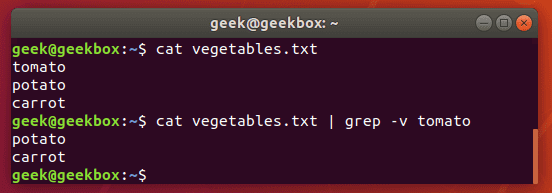
It will do the searching recursively in current working directory. When we run grep command without mentioning the file names then it will display the lines from all files that contains the matching string. :~# Example 8) Search word or pattern recursively (grep -r) List all the lines of /etc/passwd that ends with “ bash” word. :~# Example 7) Search all the lines that ends with specific word (grep $)īash shell treats dolar sysmbol ‘$’ as a special character which marks the ends of line or word. Let’s display the lines which starts with “root” word in the file /etc/passwd, run beneath grep command :~# grep ^root /etc/passwd :~# grep -v linuxtechi /etc/passwdĮxample 6) Search all the lines that starts with specific pattern (grep ^)īash shell treats caret symbol (^) as a special character which marks the beginning of line or a word. List all the lines of the file /etc/passwd that does not contain specific word “linuxtechi”. Use ‘-n’ option in grep command, In our example pattern is ‘linuxtechi’ :~# grep -n linuxtechi /etc/passwdģ9:linuxtechi:x:1000:1000:linuxtechi,:/home/linuxtechi:/bin/bashīelow is the another example which displays the line and its number after matching a word ‘root’ in /etc/passwd and /etc/shadow file :~# grep -n root /etc/passwd /etc/shadowĮxample 5) Print the lines excluding the pattern (grep -v) Let’s suppose we want list line and its number which matches the pattern or word. :~# Example 4) Search the pattern in the file along with associated line number (grep -n)

:~# grep -l linuxtechi /etc/passwd /etc/shadow /etc/fstab /etc/mtab Let’s assume we want to list the files which contain word ‘linuxtechi’ from multiple files, to do so use ‘-l’ option in grep command followed by word (pattern) and files. :~# Example 3) List the name of those files which contain word ( grep -l) etc/passwd:linuxtechi:x:1000:1000:linuxtechi,:/home/linuxtechi:/bin/bash To search ‘linuxtechi’ word in multiple files like /etc/passwd, /etc/shadow and /etc/gshadow, run :~# grep linuxtechi /etc/passwd /etc/shadow /etc/gshadow :~# Example 2) Search the pattern in the multiple files Linuxtechi:x:1000:1000:linuxtechi,:/home/linuxtechi:/bin/bash Search the “linuxtechi” word in the file /etc/passwd file, :~# grep linuxtechi /etc/passwd When we run grep command followed by search string or pattern then it will print the matching line of a file. Example 1) Search the pattern or word in a file If you are on your command line type grep –-help for more options and usage.In this tutorial we will discuss 14 useful linux grep command examples, let dive into the examples. The important thing is to read and understand the command usage and adapt it to serve your purposes. This article is not the end of grep command in Unix/Linux, we tried as much as possible to include the most common commands you are likely to use. The defined option will override any explicit option. GREP_OPTIONS This option gives you an option of specifying default options for a particular session or throughout the system. Using GREP_COLORS too also has the same effect that also supports many options Specifies the color used when the highlight command is invoked. Some of these variables are picked automatically upon installation of the operating system while others have to be defined to suit a particular environment. Using GREP Environment VariablesĮnvironmental variables control the GREP behavior. The command direction takes one direction only. The connection between one command to the next is referred to as a pipe symbolized by a vertical (|) bar. # grep export ~/.bashrc | grep ‘\ OutputData.file If you want to confirm if PATH has successfully been exported to ~/.bashrc we use the command export that will search for lines with the string PATH as follows: cpu MHz : 1999.999 cpu cores : 1 cpuid level : 13 bugs : cpu_meltdown spectre_v1 spectre_v2 The primary usage of the command should give the output in a specified format. When you are looking for a file or a program that you need to ascertain version, GREP will come to your rescue. The best way to learn about GREP is by using grep command with examples. Much as the three variations are no longer supported, it allows for applications that use them to continue running without any modifications.

Grep also stands for global regular expression print. GREP derives its name from a Linux text editor ed, which uses the similar search operation written as g/re/p.


 0 kommentar(er)
0 kommentar(er)
